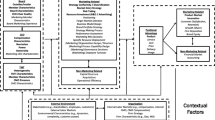Abstract
In this article, we provide a new explanation for the poor return on marketing that seems to be a problem in many industries. The literature on errors in strategic decision making is focussed on the leaders of organizations. Yet most tactical decisions regarding marketing allocation and effort are made by brand managers, and not leaders. In this article, we explore how the context in which brand managers make decisions (time pressure, colleagues with similar skill sets and the desire to advance) can cause poor marketing performance. In particular, we show how training, the exchange of advice and the management of market research lead to decisions that are not profit-maximizing. In the corporate environment, insufficient attention is allocated to understanding how these activities affect marketing decisions; hence, our description of these activities as the ‘Forgotten Side of Marketing’. We conclude by proposing a number of straightforward practices that firms can implement to better manage these activities and improve the return from marketing.




Similar content being viewed by others
References and Notes
Examples of such models are found in Kopalle, P., Ailawadi, K. and Neslin, S. (2005) Predicting competitive response to a major policy change. Marketing Science; 24(1) (Winter): 12–24; McGuire, T.W. and Staelin R. (1983) An industry equilibrium analysis of downstream vertical integration. Marketing Science 2(2): 161–192; and Kopalle, P.K., Rao, A.G. and Asunção, J.L. (1996) Asymmetric reference price effects and dynamic pricing policies. Marketing Science 18(1): 60–85, respectively.
These shortcomings in managerial decision making are explored in Leeflang, P.S.H. and Wittink, D.R. (1992) Diagnosing competitive reaction using (aggregated) scanner data. International Journal of Research in Marketing 9: 39–57, Brodie, R.J., Bonfrer, A. and Cutler J. (1996) Do managers overreact to each others’ promotional activity? Further empirical evidence. International Journal of Research in Marketing 3(4): 379–387 and Montgomery, D.B., Moore, M.C. and Urbany, J.E. (2003) Reasoning about competitive reactions: Evidence from executives’, forthcoming at Marketing Science.
This observation is found in Moorthy, K.S. (1985) Using game theory to model competition. Journal of Marketing Research XXII (August): 262–282.
These issues are explored in Grove, A.S. (1996) Only The Paranoid Survive. New York: Doubleday Dell Publishing Company, pp. 20–52 and Wind, Y. and Crook, C. (2005) The Power of Impossible Thinking. Upper Saddle River, NJ: Wharton School Publishing, Pearson Education, pp. 93–119.
SeeThe Economist. (2000) Fashion victim. 26 February 2000, pp. 73–74.
Poor returns from money invested in marketing is discussed by Santucci, S. (2004) Put your money where the value is, Productmarketing.com, 2 (4): 22–26.
The figure is intended to be representative of a comprehensive process (and not definitive). Many authors discuss a similar process with a slightly different number of steps that are sometimes named differently. For example, see Kotler, P. (2000) Marketing Management, millenium edn., Upper Saddle River, NJ: Prentice-Hall International, pp. 63–94.
The information managers use to make decisions is discussed by Bennis, W.G. and O’Toole, J. (2005) How business schools lost their way. Harvard Business Review, May: 96–104.
From Business Wire. (2001) Sixty eight percent of executives unable to measure marketing campaign return on investment, says Accenture study. 7 November, p. 1.
Badovik, G.J. and Beatty, S.E. (1987) Shared organisational values: Measurement and impact upon strategic marketing implementation. Journal of the Academy of Marketing Science 15 (1): 19–26.
Deshpandé, R., Farley, J.U. and Webster, F.E. (1993) Corporate culture, customer orientation and innovativeness in Japanese firms: A quadrad analysis. Journal of Marketing 57: 23–27.
Webster, F.E. (1994) Marketing Driven Management: Using the New Marketing Concept to Create a Customer-Oriented Company. New York: John Wiley.
Wright, P.C. and Geroy, G.D. (1991) Experience, judgement, and intuition: Qualitative data-gathering methods as aids to strategic planning. Leadership and Organizational Development Journal 12 (3): 2–32.
Kalra, A. and Soberman, D.A. (2008) The curse of competitiveness – How advice from experienced colleagues and training can hurt marketing profitability. Journal of Marketing 72 (3): 32–47.
Schotter, A. and Sopher, B. (2007) Advice and behavior in inter-generational ultimatum games: An experimental approach. Games and Economic Behavior 58 (2): 365–393.
Schotter, A. and Sopher, B. (2003) Social learning and convention creation in inter-generational games: An experimental study. Journal of Political Economy 111 (3): 498–529.
This quote is taken from Lamb, C. (1775–1834) (1987) Essays of Elia. Oxford: Oxford University Press.
The Peter Principle is a theory developed by Laurence J. Peter whereby managers rise to a level within organization just above their competence level and they then stay there for the rest of their careers. On the one hand, organizations restrict promotion to employees only after they have demonstrated competence at their current level. On the other hand, the theory implies that there are a significant fraction of incompetent managers at every level within an organization. See Peter, L.J. and Hull, R. (1969) The Peter Principle: Why Things Always Go Wrong. New York: Morrow and Company.
The mechanism by which pre-existing attitudes affect the interpretation of new information is discussed by Fazio, R.H. (1986) How do attitudes guide behaviour. In: R. Sorrentino and E. Tory Higgins (eds.) Handbook of Motivation and Cognition. New York: Guildford Press, pp. 204–243, Further discussion of this issue in the context of market research presentations is found in Barraba, V.B. and Zaltman, G. (1991) Hearing the Voice of the Market. Cambridge: Harvard Business School Press, pp. 118–119.
This argument is presented in Reicheld, F.F. (1996) The Loyalty Effect. Cambridge: Harvard Business School Press.
Please refer to Barraba and Zaltman, Hearing the Voice of the Market, pp. 118–119.
Author information
Authors and Affiliations
Corresponding author
Rights and permissions
About this article
Cite this article
Kalra, A., Soberman, D. The forgotten side of marketing. J Brand Manag 17, 301–314 (2010). https://doi.org/10.1057/bm.2009.25
Received:
Revised:
Published:
Issue Date:
DOI: https://doi.org/10.1057/bm.2009.25




